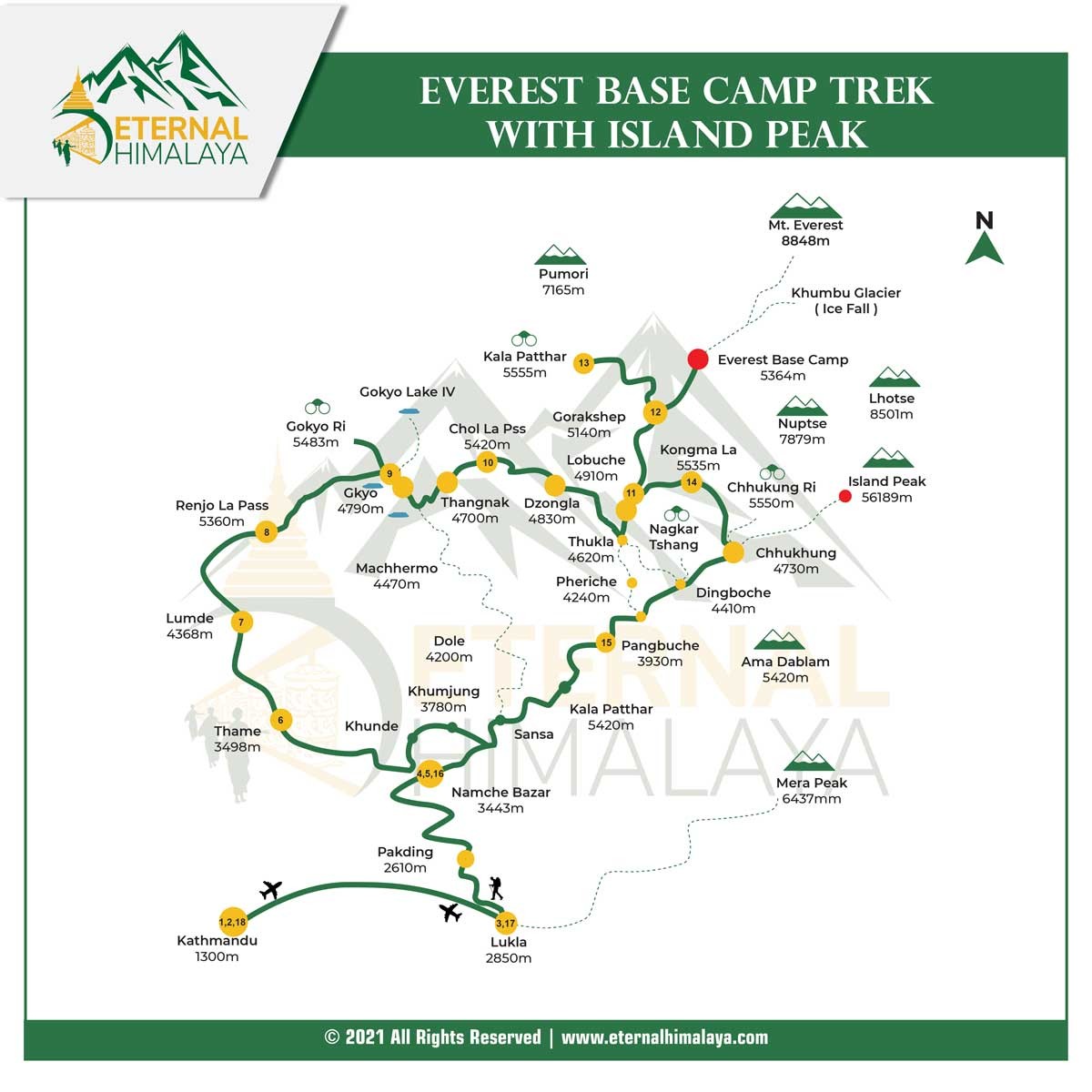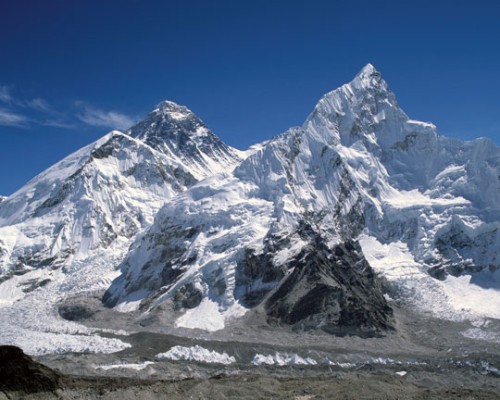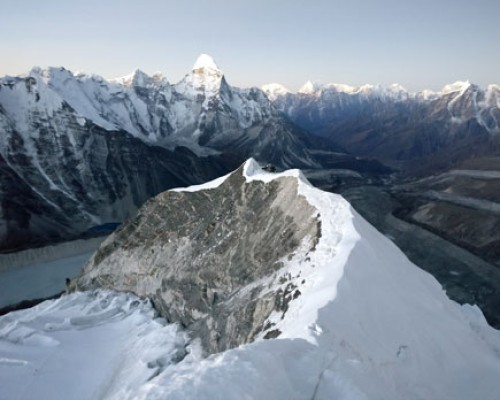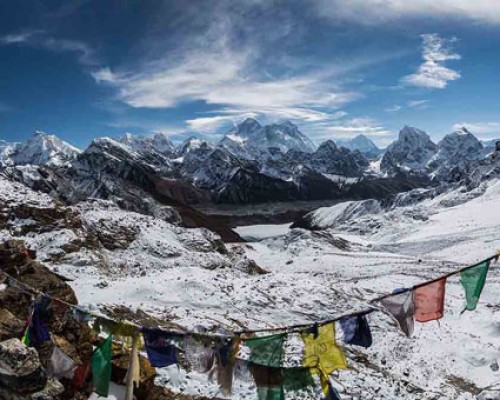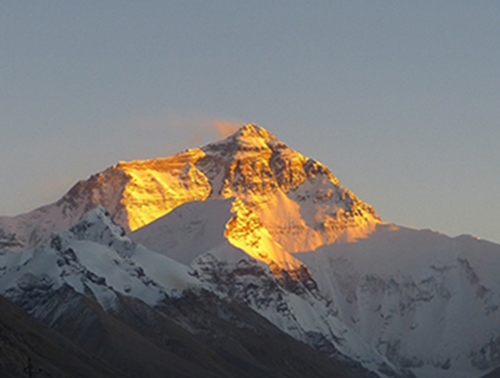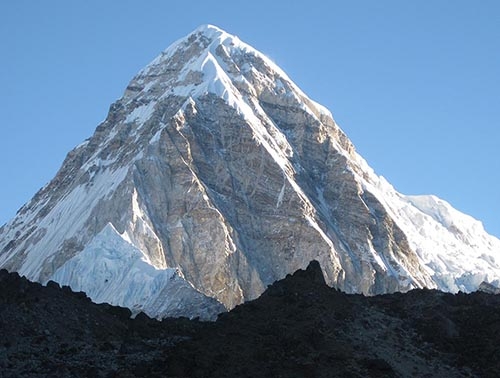Difficulties/Trip Grade: Fitness Level and Health
Island peak climbing is a thrilling adventure as well as very challenging. However, trekkers with good strong physical condition and basic mountaineering skills as well as some technical knowledge could accomplish the Island Peak summit. It’s not necessary to have these qualities as brief climbing training will be given. However, trekkers need to be physically strong enough to do strenuous activities because you will be climbing on rocks and ice on vertical slopes with the use of ropes, ice ax, snow boots, and crampons. Those people who have climbed or trekked any other trek like Everest Base Camp trek or Kilimanjaro can easily go for Island Peak climb.
Island Peak consists of numerous challenges on the way. One of them is the foot of the headwall which is the toughest part of the climb and even the ascent is very steep. The Island peak climb gets difficult at an extremely high altitude as the air gets at its thinnest level. Nonetheless, the climbing route is safe with fixed lines up to the summit.
Health and safety of our clients are paramount during the trek so we do not recommend this trek to those who suffer from serious medical conditions such as heart and lung diseases.
A typical day on Island Peak Climbing Itinerary :
On a normal day of Island Peak Climbing schedule, trekkers will gather extraordinary experiences by admiring the astounding vista of Mother Nature such as Himalayan ranges, glaciers, lakes, wildlife, vegetation, exploring local villages, taking pictures, and learning about their cultural traditions. In the course of the expedition, you will be escorted by a well-experienced, good-natured and proficient guide/trek leader. The guide shares the historical facts and information about the places you will be visiting on the way. Porters will also be on our team to assist the trekkers in carrying their luggage. But trekkers should carry one small regular day backpack for necessary items.
The early morning begins with a nourishing breakfast and a hot cup of coffee/tea, before that we pack our bags first. Then after filling our bellies we set out on the day's walk. After hiking for 3 to 4 hours, we stop for lunch at around midday and take a rest for an hour then continue the journey.
Usually, afternoon walks are shorter but they could be longer in some cases depending upon the duration of the destination and the walking pace of trekkers. Mostly we arrive at our destination at the time of afternoon tea. We will snack on the food as soon as we reach our overnight lodge/teahouse and we’ll spend the remaining afternoon exploring nearby villages, freshening up, or simply relaxing and enjoying the book with beverages. On some days we may arrive early at our destination by lunchtime and the entire afternoon will be free for you to explore more.
From around 6 PM to 7 PM dinners will be ready. After having dinner, we will often spend the evening involved in friendly conversations, playing cards, board games, etc. The tour guide will give us a briefing about the next day. When the briefing session ends we'll continue playing, communicating, and watching documentaries. Some of them will try to learn a few Nepali words from crew members, write a diary or read books for a couple of hours. Then head towards the bed for a good night's sleep. Every day of the trek is the same as mentioned above.
Meals :
This trek requires a lot of physical strength and energy to trek and climb uphill and downhill toward Everest Base Camp and the challenging Island Peak. So, while trekking your body will be in desperate need of nutritional food and pure drinking water. To fuel your body you need to consume food that contains nutrients like carbohydrates, protein, and fat which provides energy for your muscle, heart, brains, and lungs.
As the lodge’s menu consists of Asian, western, and traditional local (Tibetan) cuisine, there will be plenty of options for you to choose from. We selected the best lodge which will serve you fresh, tasty, hygienic, and healthy meals from their available menu items. The menu items will be limited in high altitude lodges whereas the prices of food increases.
Although you can't get the food like in the city areas, the available meal on this trek is very suitable in such situations.
We will provide you with Breakfast, Lunch, and Dinner on this trek. When you are at a high altitude it is highly suggested to intake liquids like lemon tea, green teas, plain boiled water, ginger tea, hot lemon, garlic soup, etc. The best meal for the trek is fresh vegetable items which give health benefits. There are also plenty of non-veg items available but we won't recommend any of them. Because the meat is not healthy and hygienic enough to consume in trekking areas. During the high elevation trek, we strongly suggest avoiding any kinds of dairy items like cheese. Experts suggest avoiding the consumption of caffeinated items, alcoholic drinks, and hot chocolate throughout the trek.
# The cost of standard meals (Breakfast, Lunch, and Dinner) is included in the package. But all the prices of personal snacks and drinks (Alcoholic drinks, hot or cold beverages) are excluded from the package.
Accommodation:
Eternal Himalaya has selected the best service-providing hotels to ensure our clients are comfortable and cozy before and after the trek. In Kathmandu, you will be staying at a 3-star hotel on B&B basic which is already included in the package.
While on the trek, trekkers will be accommodated in the best available Teahouse/lodge where they provide other services as well. The accommodation at Everest's highest region’s lodges is basic structures made of wood or stone with generally shared bathroom/toilet, mostly built outside, and often a squat style toilet is available. Nonetheless, these lodges will provide you with comfortable warm beds and hearty meals in such remote places.
In the lower elevation of the trekking region at Lukla, Namche, and Pakhding, some of the lodges/teahouses may be multi-story structures and provide twin sharing rooms with attached private western style bathroom facilities. As you climb higher the quality of lodges declines. Single accommodation is hardly available above Namche.
Once you reach the Island Peak Base Camp, you will be accommodated in tents.
Best time For Climbing Island Peak with Everest Base Camp :
The weather is the most important factor to observe while planning for an Island peak with Everest Base Camp Trek.
To climb Island Peak Via Everest Base Camp in favorable conditions, you have to study and understand the weather and climatic condition of the Everest region. Although you can get the live weather forecast of the Everest region, it still is difficult to predict the exact weather as the weather can change from time to time.
Trekkers trek Everest Base Camp and climb the Island peak the whole year round but they do face some extra difficulties on their way in every season. The ideal time to trek/climb is during the spring (March to early June) and the autumn (September to November) seasons. The Spring season is the busiest climbing season of the year whereas the fall/autumn season is the most popular season among climbers as the rainy season ends, the temperature becomes moderate with crystal clear blue sky and the sun-blocking thick clouds will fade away. Since the weather tends to be clear, it will make up the most captivating sight.
January to February
From early January to early February is the coldest time of the year. This is the time when the mountain receives a heavy snowfall which results in extremely cold temperatures. It is possible to climb Island peak throughout the year, even in winters like in the past winters some climbers have attempted to climb the Island peak before, but the extreme cold of winter months could be dangerous and can put you in a vulnerable position.
The daytime may be warm with clear blue skies and good visibility, whereas the nighttime would be cold; nevertheless, we Eternal Himalaya will make sure to safely guide you during the trek. If you have any allergies related to the cold, trekking during these months can be fatal.
# Maximum temperature reaches 15°C in the daytime and the minimum temperature falls to -15°C at night and morning.
March to April
This is a peak season for the climbers and also, the busiest. The month of March is the beginning of the Spring season, so the weather begins to warm up and provides favorable weather conditions. Because of good visibility and perfect climate you can view the breathtaking Himalayas ranges and glaciers as well.
During these months you get to see amazing landscapes, blooming flora (rhododendron and Himalayan wildflowers), and active fauna. There is a high chance of succeeding in the expedition at this time.
# Temperature would be around 18°C during the daytime. At night, the temperature drops to -12°C.
May to June
It's also the best-suited month to trek just before the rainfall season. In Nepal, the monsoon starts from the end of June till mid-August.
# Maximum temperature is around 25°C in the daytime and drops down to around -5°C at night.
July to August
It's going to rain heavily during this time, especially below 3500 meters. The flight of Lukla gets canceled while starting or departing after completion of the trek due to a downpour. Despite the heavy rainfall, trekkers still visit the Everest region in these months. It is demanding to trek in these months, yet not impossible. It is best to avoid these times because of unfavorable weather and poor visibility you will have limited views while climbing the Island peak. The trails get wet and slippery as well making it riskier and sometimes leading to landslides because of continuous rainfall. So, keep checking on the weather forecast. It will not be crowded compared to other months but most lodges might be closed during the off-season. Despite all obstacles, you can enjoy the view of a mesmerizing waterfall. But at last, we suggest you not trek during these months for your safety. If you want to trek during this time, the Eternal Himalaya guide will take proper care of you.
# Temperature will be around 27°C at daylight and 5°C at night.
September to October
These months are the perfect season for the EBC and Island peak expedition. Since the monsoon season ends, it provides stable weather conditions for trekking. Due to favorable weather, this time is considered to be the peak season for tourists. During this season trekkers enjoy trekking a lot, with a spectacular view of mountains and a clear sky with no clouds.
We recommend you to visit EBC and Island peak for trekking/climbing usually from mid-September to the end. Around this time tourists can enjoy the great festivals of Nepal: Dashain and Tihar.
# Temperature rises to 20 degrees in the day and falls to 5 degrees at night.
November to December
Slowly the winter will start along with snowfalls in mountain regions, nights get extremely colder and in the end, makes it difficult for trekkers to trek. In November it gets busy as people from all over the world come to take advantage of the sunny and bright day with a clear sparkling view of majestic mountains. From December it will be foggy and cloudy due to freezing temperatures and snowfall will begin.
# The temperature in the Himalayas differs frequently from day to night as the weather in the Himalayas is unstable.
Acclimatization During Island Peak Expedition :
Acclimatization is highly recommended in Island peak Expedition. Many trekkers often suffer from altitude sickness. Altitude sickness should not be taken lightly because if it is left untreated it can progress into HACE or HAPE. So, immediate treatment should be given when symptoms show up. Trekkers must ascend gradually and take it easy.
Climbing Island Peak at an extreme altitude is not an easy task, but you can overcome the difficulties by spending more days en route. Island peak expedition is tough in comparison with the Everest Base Camp trek To adapt to a new climatic condition and high elevation of Everest regions we will be acclimatizing in Namche Bazaar and Dingboche.
Eternal Himalaya guides are well trained and are capable of professionally handling any situation. Our guides have extensive first aid training and they always carry the first aid kit for emergencies. They will supply you with medicine in case you don't have it and provide you with immediate treatment. If trekkers have altitude sickness with severe symptoms then immediate descent at a lower altitude is necessary. Then the guide will make the decision based on the overall health conditions of the trekker whether to continue or discontinue the trek.
Trekking in-group/singles:
We handle all group sizes whether it be small (private trek) or large size trekking groups. Group discount is applicable when your group consists of more than 5 people and should have your person (family, friends, or colleagues) in the team otherwise the price remains the same for private touring or group joining. If you are interested in joining the fixed group for this trip please keep checking the departure link when it's available we will send you complete info (dated and price) related to the trek or you can book an entire private trip at a reasonable cost. Every group will be led by a team leader/ guide and one porter for two trekkers. In case your group exceeds more than 10 people we will provide an assistant guide.
Immunization Certificate/Vaccination :
The requirements of vaccination keep changing frequently, so it’s better to consult your doctor at least 2 months before the beginning of the trek. We recommend you get vaccinated against malaria, tetanus, typhoid, hepatitis, and polio.
Please note that all the clients are required to be ‘Fully Vaccinated’ against Covid-19.
Nepal Tourist Visa :
Visa is obligatory for all foreign nationals except for Indian citizens. Tourists can obtain a 'Tourist Visa-On-Arrival' at the Tribhuvan International Airport (TIA). Fully vaccinated foreigners are eligible for Nepal tourist visas.
At least 6 months validity of the passport and a passport size photo is required for visa application. Visa extension can be done at the Department of Immigration, Bhrikutimandap, Kathmandu. You are required to pay the visa fee on arrival at the airport (TIA) in cash. To know more information about visas and the current cost of visa fees, you can visit this site www.immigration.gov.np.
Chinese nationals and SAARC citizens can receive a free visa. Nationals of Nigeria, Ghana, Zimbabwe, Swaziland, Cameroon, Somalia, Liberia, Ethiopia, Iraq, Palestine, and Afghanistan Countries have to acquire a visa before they arrive in Nepal as they may not receive the on arrival visa. Moreover, they have to visit or contact their close Nepalese embassy for a visa.
Personal Expenses :
Accommodation for three nights in Kathmandu with only breakfast is included in the package except lunch and dinner are up to the clients.
All our precious clients have to pay for international airfare and airport departure tax. Other additional expenses that clients are required to cover are travel insurance, Nepal Tourist visa fee, tips for trekking staff, personal trekking, and climbing equipment. All meals (breakfast, lunch, and dinner) are provided during the trek but clients will have to bring extra money with them while trekking to cover the cost of table drinks (alcoholic and nonalcoholic beverages), snacks, souvenirs, hot shower, charging devices, etc.
Since Nepalese currency is only accepted in the Everest region, we suggest you bring enough Nepali rupees during the trek for your extra personal expenses.
Electricity for battery recharge and drinking water on the trek :
Every lodge in the Everest region has electricity which is mostly generated from hydroelectricity and some lodges generate electricity from solar panels. In all lodges, electricity is available to guests for recharging any devices: phones, tablets, cameras, etc by paying an extra cost.
For pure drinking water during the trek, you can either buy the mineral water from local shops and lodges or keep refilling your water bottle with boiled water from the lodges at an extra cost which is an effective way to get purified water and it won't pollute the environment. Moreover, the use of portable water purifying gadgets and water purifying tablets also help to filter pure drinking water.
# Do not drink water from the tap, well, river, or any other water sources of the mountain region as it is contaminated with bacteria, parasites, and viruses.
Wi-Fi service and communication on the Island Peak Climbing :
Wi-Fi services are available in all the lodges in the Everest region. They will charge you extra money for the usage of internet service. Other ways to access the internet are by purchasing a local sim card (Ncell SIM card) and buying a lot of data bundles for reliable wireless internet for the whole trip. After arrival in Kathmandu, you can ask the tour operator or guide to assist you in purchasing a SIM card.
Furthermore, Eternal Himalaya can provide you with a mobile satellite phone which comes with a rental charge on request, if you must contact your family members or others. Normally, after reaching high altitudes communication is done by phone for safety purposes. At least once a day we (Eternal Himalaya) will be in touch with our valuable clients through your trek leaders to be notified about your whereabouts and to ensure the safety of the clients. As you will be in contact with us (Eternal Himalaya's office) every day, you can receive any kind of help during the trek.
Travel Insurance for Everest Base Camp and Island Peak Trek :
The Island Peak expedition is considered to be very strenuous since this trip involves potential risk factors of trekking/climbing at high altitude such as the occurrence of unforeseen events along with sudden climate change, and the possibility of suffering from high altitude sickness, injuries, and avalanche, etc.
Travel insurance is the key document for trekking in Nepal. A copy of the detailed travel insurance policy certificate/insurance information needs to be submitted after booking the trek which should be sent via email. Those insurance policies and information documents sent by you (clients) will be useful for emergency cases which will help us carry out quick and effective rescue operations, deliver urgent medical treatment, etc. The client must ensure that their insurance company includes the cost of mountain rescue service at the highest elevation of the trek. The Policy of travel insurance has to cover the expenses of medical evacuation, emergency repatriation including helicopter rescue and evacuation at high altitudes from up to 6000m for the trekker's safety.
If you don't have travel insurance, we can advise you in recommending the Travel Insurance agencies but there won't be any involvement from our side in the insurance policy's sale.
Trekkers/clients who don't acquire travel insurance and whose travel insurance policy doesn't have a required or sufficient policy for the trek (inadequate, inappropriate travel insurance policy) are not allowed to trek.
#Please do call and recheck to ensure that their insurance policy has Heli-rescue and evacuation up to 6000m or depending on your trekking/ expedition height. Don't trust what they have mentioned on websites as saying goes "Better safe than sorry".
Currency Exchange in Nepal :
Nepali currency (Rupee) is a closed currency; therefore, you can only exchange your foreign currency upon arrival in Nepal. Since US dollars are widely accepted, we suggest traveling with US dollars. The majority of banks do not accept a foreign currency that is old, torn, or faded. It is advisable to carry new, clean and untorn notes to obtain the local currency ‘Nepali Rupees (NPR)’.
The foreign currency can be converted through local banks or a bank ATM and authorized ‘’Money Changers’’ or ‘’Foreign Exchangers (FOREX)’’ around Thamel in Kathmandu. Alternatively, you can exchange a small amount of cash at all the hotels in Kathmandu too. Every morning the money changers will post the ongoing rates on their board which is placed outside of the store. The rates don't vary that much from store to store.
Some of the ATMs are open 24 hrs a day and accept the international card; moreover, most ATMs will charge a usage fee on each transaction. Cash from ATMs is given out in Nepali currency (NPR) only. In Nepal, there is a limit on how much amount of cash you can withdraw per transaction. If you are using a foreign card, the maximum limit of withdrawal amount will be 35,000 for a 500 rupees processing fee. However, the withdrawal amount varies depending on the bank and the limits often range from 10,000 NPR to 30,000 NPR.
A service fee charge of 4% or more will be imposed depending upon the banks if you utilize the money exchange facility at financial institutions and banks.
On the trek, there are no money exchange services or banks. Furthermore, there are some ATMs available in large trekking towns like Namche Bazaar and Lukla on the Everest Base Camp route but are not reliable. So, we suggest you exchange your foreign currency in Kathmandu before you depart for the trek, as you will get a more favorable exchange rate. Plus, it is a far more convenient, easier, and safer option. Since the tea houses/lodges of trekking regions prefer local currency, we recommend you to take a sufficient amount of Nepali currency on the trek for personal expenses.
# We advised you to avoid the airports and hotels to make your currency exchanges, for the best rate.
How much luggage can I take during the EBC trek and Island Peak Expedition?
The weight allowance for Nepal’s internal flight is 15 kg as domestic airlines operate strict limits of a maximum of 10 kg for main luggage and 5 kg for a backpack. If your luggage exceeds 15 kg, you have to pay for the excess baggage weight which will cost USD 1 or more per kg depending on the region. Furthermore, the weight limit for the peak climbs is specifically tight because of the climbing kit, and therefore the weight limit for your luggage during the peak climbs is 10kg per trekker. Only one porter is assigned to carry one trekker's luggage during the climb. In some cases, the flight exceeds its full capacity to carry extra weight and is unable to carry extra luggage as it overweights the flights. In such a situation the airline will re-packed the climbing gears separately and send them on the next available flight. The porter will collect the upcoming remaining luggage and then carry it to you on the trail. All the items should be packed inside the main bag. None of the items should be attached or hooked outside the bag as they may fall off and get lost on the way while being carried on the trek. We won’t be responsible for the loss and damage of the trekker's belongings.
Normally, we assign one porter to carry the main luggage of two trekkers during the trek. The weight limit for the luggage is 9kg per trekker. As one porter will be carrying the weight of the two trekkers, the combined weight will be 18kg. We care for the porters and against exploitation, so we do not overload our porters. If you need an additional porter to carry your excess luggage, we can arrange the porter for an extra charge. Moreover, trekkers should carry their backpacks by themselves and their backpacks are packed with valuables, possessions, and important belongings needed during the day. It is advisable to carry the essential items only, as you can leave and store any excess luggage either at your hotel or at the Eternal Himalaya office's storage room for free. We will keep your baggage safely stored.
Before we begin our trek, we will recheck the equipment, luggage, etc in the course of briefing at our office.
Responsible Travel :
The magnificent beauty of the Himalayas is unparalleled yet extremely fragile enough to disrupt the ecosystem of the mountain region. The growing local population and increasing numbers of trekkers impact the environment of Mountain regions. Eternal Himalaya works side by side with the Kathmandu Environmental Education Project (KEEP) to preserve and protect the beauty of the environment for future trekkers to relish and explore. We are fully aware of the consequences of tourism in mountainous regions, so we encourage the trekkers to minimize the negative impact on nature as much as possible. As garbage disposal is a major issue, we request our clients to dispose of the litter in provided bins and if there are no bins at a high altitude you can carry it to dispose of later. Trekkers can go for eco-friendly alternatives such as carrying reusable water bottles to refill the boiled/filtered water rather than buying bottled mineral water and using water sparingly. Water resources should not be polluted with trash.
Eternal Himalaya Trekking Crews :
Throughout the expedition of Island Peak via Everest Base Camp, our well-trained expert Sherpa guide will escort you to make you feel secure and comfy. All of the climbing guides are high-level experts in mountaineering. Climbing guides are certified and skilled in mountain climbing, ice climbing, and rock climbing as well. Your guides will ensure that you and your team members can have a safe experience while climbing the peak. Our Sherpa leaders and guides have experience of many years and have led numerous trips to Island Peak.
Our trek leader/guide's specialized qualities are as follows:
- A well trained certified Trekking guide
- High-level experts in mountaineering (Rock Climbing and Ice climbing)
- Excellent interacting skills and fluent in English and other languages
- Undertook the Biodiversity and Conservation course
- Wilderness First Aid Training
- Keeps track of weather forecast and Well informed about facts
Staff’s Care :
Our staff is the backbone of the company, so we make sure that all our outdoor staff (porters and guides) are fully insured and well equipped for high-altitude treks/expeditions. Eternal Himalaya offers a good salary to porters, guides, and other trekking staff as well. All the porters and guides are provided with a medical kit, food, accommodation, adequate clothing, and climbing gears throughout the trek. Medical care is given to all our guides and porters in case of injuries and illness.
Tipping on the trip :
Tipping may not be a widespread practice in all countries, whereas in Nepal it is a common practice, especially in tourism sectors besides that, the tourist has the liberty to evaluate and make a decision on whether to tip or not to tip and how much to tip based on the services provided to you and team performance considering how well the team served you while you were on the trek.
Tips have always been discretionary for travelers. If you received good service and want to reward the porters and guides you can tip them at the end of the trek. It would be a good gesture from your side to offer a gratuity to Sherpas for assisting and leading you during the climb. In Nepal tipping is a part of the culture and we accepted it as an appreciation for our good service. In case you are not satisfied with the service that you have received on the trek, you are at liberty to not tip, and please do give us feedback for improvement.
Booking and Payment process :
Our company has all the necessary documents and approvals from the government to operate the trekking, tour packages, and other tourism activities. We have the membership in Nepal Mountaineering Association (NMA) and Trekking Agency Association of Nepal as well. Hence, it is safe to book your desirable trip with Us.
To book a trip with us (Eternal Himalaya Adventure Pvt. Ltd), you have to fill up the 'Booking Application Form'. Moreover, you have to pay 20% in advance for booking confirmation before the trip and a 20% deposit is non-refundable. After that, you need to send other necessary documents such as travel insurance, passport size photo, passport copy, arrival, and departure flight details later but they must be submitted within two weeks from the booking date.
The remaining 80% payment can be paid in cash or bank transfer and credit card after you arrive in Kathmandu. For advance payment, you may pay us through bank transfer, online payment (directly from our website), and western union. Besides that, we will be forwarding you the email about the necessary modes of payment details.
Trip extension Everest base camp with island peak :
Apart from the trek, our company organizes other trips within Nepal, Bhutan, and Tibet. If you want to stay for extra more days after completion of your trek, we can arrange (tours and other adventure activities) to extend the trip for the clients. When the trek ends, you will have spare time and you may want to go for adventure activities such as river rafting, cycling, paragliding, zip flyer, bungee jumping, etc. You may as well explore exotic places around Kathmandu and many more.
Feedback :
Once completing the Everest Base Camp trek and Island Peak expedition you will be enjoying a farewell dinner arranged by the Eternal Himalaya to celebrate the successful completion of your trip. Our company will honor you with a certificate of trek achievement.
It would be a pleasure to get a helpful response from our clients about our services provided and team presentation throughout the trip. We would appreciate the request and accept the flaws to improve our services.
Equipment lists for Island Peak Expedition and Everest Basecamp trek :
The following is a suggested list of the gears which should be brought by you. Clients can also buy or hire climbing equipment in Kathmandu. While buying or renting the gears, don't forget to get the right size gears. Each trekker has to carry one daypack for their basic and personal items required during the day. Your day backpack will contain items like a jacket, warm clothes, a water bottle, snacks, a personal first aid kit, an electronic device (Laptop, Phone, Camera, etc), important documents, money, or other valuable items, etc. Porters will be carrying the rest of the main luggage and climbing kit packed in a duffle bag or backpack. As we care for porters' rights and against any exploitation, we do not allow the maximum weight of luggage to exceed more than 18 kg.
Climbing Equipment
- Alpine climbing Harness
- Ice Axe
- Crampons
- Screwgate Carabiners × 2 (lockable)
- Regular Carabiners × 3 (non-lockable)
- Rope
- Tape slings × 2
- Belay/Rappel device (figure 8 descender preferred)
- Ice Screw
- Ice Hammer
- Climbing Helmet - UIAA tested
- Walking/Trekking pole
- Ascender or Jhumer device
- Plastic mountaineering boots
- Prusik Loops
- Snow bar
Head Gear
- Warm insulated hat (wool/fleece/synthetic hat which covers your ears) - e.g. Beanie
- Wide-brimmed Sun hat or shade hat/ jockey cap
- Face mask
- Neck gaiter
- Balaclava or ski mask
- Scarf/headscarf or bandana (useful in dusty conditions)
- Glacier glasses with 100% UV protection
- Ski spectacles/Snow goggles and Sunglasses with 100% UV protection lenses (carry an extra pair just in case other pairs break or are lost)
- Prescription sunglasses (if required)
- 2 LED Headlamp with spare batteries
Face/body care items
- Sunscreen with SPF above 50
- Sunglasses with UV protection
- Face/body cleansing wipes (biodegradable wipes)
- Moisturizer lotion for face/body
- Lip balm with high SPF
Hand Wear
- Fleece gloves or wool (lightweight)
- Liner gloves × 2 pairs
- Summit Mittens or warm insulated gloves (with safety straps)
- Expedition Shell gloves
Body Wear: Upper and Lower
- T-shirt (breathable and moisture absorbing)
- Long sleeve shirts (breathable and moisture absorbing )
- Waterproof jacket and trousers
- Trekking trousers
- Hooded rain jacket
- Midweight down jacket
- Microfleece jacket
- Fleece pants
- Windproof fleece jacket or pullover
- Thermals or baselayer for top and bottom (merino wool or synthetic)
- Down vest or Sleeveless or body warmer type fleece
- Mid to heavyweight fleece
Footwear
- Liner socks × 4 pairs
- Lightweight Trekking socks × 3 pairs
- Wool socks × 2 pairs
- Trekking Boots (with good ankle support)
- Trainers or running shoes
- Sandals
- Gaiters
Sleeping
- 5 season sleeping bag (suitable for as low as -40°C temperature)
- Fleece sleeping bag liner
- Foam pad
- Sleeping pad (for warmth and insulation in sub-zero temperature)
- Pillowcase
- Waterproof rucksack covers × 2 (if required)
Essential gear
- Backpack large enough to carry essential
Toiletries
- Medium sized towel (quick-drying)
- Biodegradable soap
- Multi-purpose biodegradable soap
- Toilet paper
- Toothbrush
- Toothpaste (preferably biodegradable)
- Deodorant
- Small sachets of Shampoo
- Nail clippers
- Small mirror
- Female hygiene products
Medical
- Compact first-aid Kit (simple and light)
- Plasters (Band-Aids) and First Aid tape
- Skin-blisters repair kit
- Sterile wet wipes
- Antacid (for indigestion)
- Antiemetic (for vomiting and nausea)
- Paracetamol
- Anti-Diarrhea pills
- Throat lozenges or hard candies
- Altitude sickness pills (Diamox or Acetazolamide)
Personal Hygiene
- Tissue
- Wet wipes
- Hand sanitizer
- Antibacterial handwash
- Pee funnel (for females)
- Pee bottle (of 1 liter capacity, wide mouth, and leak-proof )
- Extras/Luxuries



